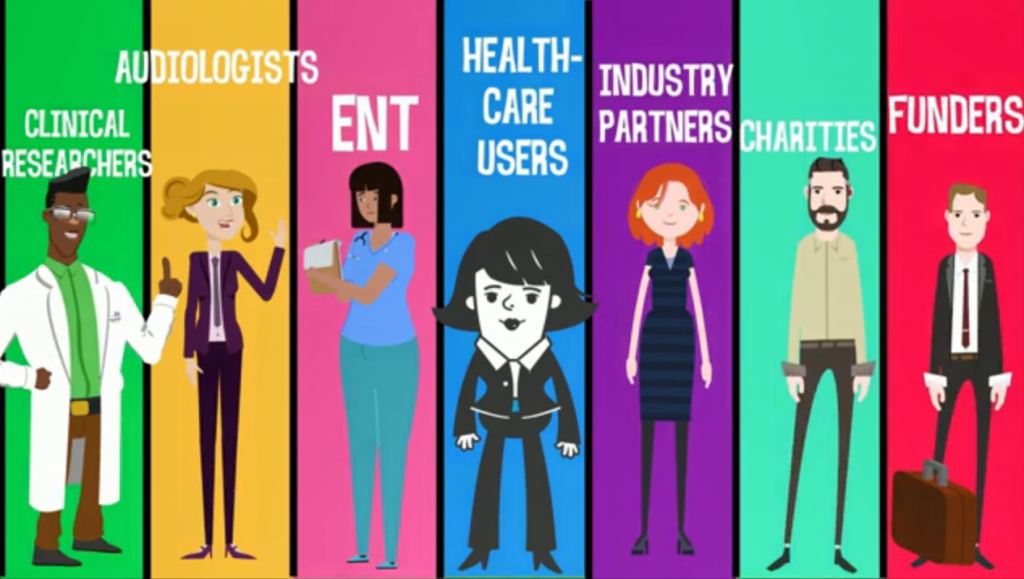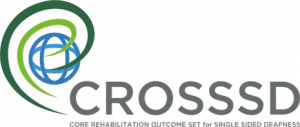February 25, 2022, by Adele Horobin
Helping research improve treatments for single-sided deafness more quickly – An agreement on what is important to measure

Audiologist and PhD student Roulla Katiri
Roulla Katiri, on behalf of the CROSSSD initiative, for Hearing Matters UoN blog.
Much clinical research sets out to improve and develop new treatments for health conditions. But usually, no one piece of research is enough to be sure which treatments are best. We need to build up a body of many different research studies and then compare results across them. However, if different studies measure different things, it can be difficult to make sense of it all.
That’s where core outcome sets come in. The aim is to encourage all researchers to measure, as a minimum, the same set of effects, or outcomes. This is so we can build a picture of which treatments work and don’t work more quickly. Read on to find out more about the new core outcome set for single-sided deafness.
The Core Rehabilitation Outcome Set for Single-Sided Deafness (CROSSSD) study set out in 2017 to develop a core outcome set for single-sided deafness (SSD). SSD, also known as unilateral hearing loss is a condition where there is normal hearing in one ear and a severe-to-profound hearing loss in the other ear.
Research into treatments for SSD has increased a lot over the recent years, which is fantastic! However, different studies capture different benefits or harms (known as ‘outcomes’) which makes it very difficult to work out which hearing device is ideal. Examples of the many outcomes that have been used in SSD studies include how well an individual can hear speech above noise, how easily they can locate a sound, or how a device affects their quality of life.
The primary focus of the CROSSSD study was to agree on which outcomes are important to capture for everyone involved in SSD: healthcare users diagnosed with SSD, audiologists and ENT surgeons working in the field, device manufacturers, and clinical researchers.
The CROSSSD team took the following steps, as outlined in our published protocol:
Step 1: Make a comprehensive list of all outcomes reported in studies to date.
Step 2: Invite healthcare users and professionals internationally to vote on the importance of these outcomes according to their own personal experiences.
Step 3: Discuss the most important outcomes in an interactive consensus meeting with healthcare users and professional representatives, to agree on a final core outcome set.
 An amazing 308 healthcare users and professionals from 29 different countries took part in the voting. Then 12 of our participants met up and discussed the outcomes during a 7-hour long online meeting. A decision was made on three outcomes that are very important to everybody involved.
An amazing 308 healthcare users and professionals from 29 different countries took part in the voting. Then 12 of our participants met up and discussed the outcomes during a 7-hour long online meeting. A decision was made on three outcomes that are very important to everybody involved.
The three outcomes are:
(i) Spatial orientation (knowing where you are in relation to the position of a sound source),
(ii) Group conversations in noisy social situations (listening and following a conversation between a group of people, when others are talking in the background), and
(iii) Impact on social situations (your hearing loss or device limiting your ability to fully participate in the social world; especially in challenging situations or where a lot of effort is needed to follow the conversation).
 Our short video tells you more about the CROSSSD study and outcomes.
Our short video tells you more about the CROSSSD study and outcomes.
This was the first time experts, including both healthcare users and professionals, discussed how we assess the benefits and harms of the various hearing devices and auditory implants for SSD. The comments below show how it was a valuable experience for everyone involved.
“I was a little apprehensive about taking part in such a conference for the first time, but it went much better for me than I expected. It was fascinating for me to hear about other patients’ experiences.” [Chris, healthcare user with SSD due to acoustic neuroma]
“Bringing together people from a variety of specialisms encouraged an active and productive discussion, and the experience was educational for all. It was an honour to represent the healthcare user and to be involved in the making of important decisions that will shape the future of SSD research.” [Carly, healthcare user with SSD due to sudden onset hearing loss]
“It’s nice to give something back and hopefully there will be some benefits that we might all enjoy.” [Richard, healthcare user with SSD due to acoustic neuroma]
“Thank you for giving a voice to us with SSD, its brilliant to see progress being made, and whatever we give to this study the better the outcomes for those who get diagnosed with SSD in the future.” [Nicky, research partner, CROSSSD study]
“It was a very interesting exercise, it is always really nice to hear what other people are thinking. I have been in the field for quite some time now but I have better thoughts now than before we started the consensus meeting this morning.” [Ad, audiologist and clinical researcher in SSD]
“I was fascinated to listen to the conversations, to hear what goes behind my office doors… I do really appreciate hearing from a patient’s perspective, from an audiologist’s perspective, what happens in addition to the very brief encounters that I have with patients, which more often than not don’t portray everything that goes into this decision, which as a surgeon I take for granted. I am excited to implement the recommendations in my own practice.” [Daniel, Neurotologist and clinical researcher]
“It was really nice to be involved in something where patients had such a great voice, it is obviously such a big part of research in the UK, but it’s the first time I got so immersed, I really enjoyed that, everyone shared their personal experiences and why things are important to them.” [Cherith, device manufacturer representative]
“One of our big goals is to make sure there is more research in this field and that more attention is given by scientists but also device manufacturers to how we can make better devices for all types of people with SSD.” [Padraig, CROSSSD study management team]
The CROSSSD study is led by Audiologist and PhD student Roulla Katiri, supervised by Dr Derek J. Hoare and Dr Kathryn Fackrell.

Further information:
CROSSSD study website: www.nottingham.ac.uk/go/CROSSSD
*Short video introducing the CROSSSD study and core outcome sets: https://youtu.be/CFBC3Wv5_8s
*Short video explaining the CROSSSD core outcome set: https://youtu.be/BcUy_2bzHZw
CROSSSD on Twitter: @CROSSSD_ https://twitter.com/CROSSSD_
Roulla Katiri on Twitter: @roukat https://twitter.com/RouKat
Carly’s blog on taking part in surveys: https://myhearinglossstory.com/2019/09/26/crosssd-study-you-can-help-with-vital-research/
Carly’s blog about taking part in the consensus meeting: https://myhearinglossstory.com/2020/08/03/working-together-to-develop-the-research-of-treatments-for-single-sided-deafness/
Summary of available SSD treatments: https://suddenhearingloss.support/2021/03/21/what-if-your-hearing-does-not-recover/
*Videos created by http://www.sciencesplained.com/ for the CROSSSD study.
No comments yet, fill out a comment to be the first

Leave a Reply